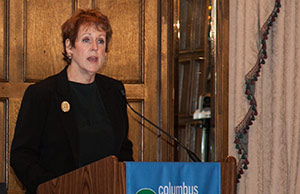Chief Justice O'Connor: Lack of Court Funds is an Access-to-Justice Problem

Chief Justice Maureen O'Connor speaks with members of the Columbus Metropolitan Club about court funding.

Chief Justice Maureen O'Connor speaks with members of the Columbus Metropolitan Club about court funding.
Chief Justice O’Connor said 42 states, including Ohio, cut their courts’ budgets in 2011, reducing access to justice for millions of Americans through layoffs, reduced court hours and other money-saving measures.
Chief Justice O’Connor said that while courts must contribute their share to address state and local budget deficits, there are limits to how far court budgets can be cut.
“We cannot inconvenience Ohio’s citizens by closing our door,” Chief Justice O’Connor said. “We have to keep the doors open. We have to be accessible. We can’t curtail the hours because citizens need to access the courts.”
“This is a sad situation because the general populous doesn’t understand the role of the courts, the significance of the courts, the position of the courts in balancing our representative democracy to assure access to justice and rule of law, which is so essential to our ongoing society,” Robinson said.
Last year Chief Justice O’Connor established a bi-partisan, 29-member Task Force on the Funding of Ohio Courts to examine the current structure and the funding of the judicial branch. She said determining where the courts currently stand continues to be a challenge.
“Because of the way in which the Ohio judicial system is structured and funded, there is no collective dollar amount that can easily be identified that’s dedicated to the judicial system in Ohio,” Chief Justice O’Connor said. “We do need to find out what the dollar amount is that is allocated currently for our systems. Are they being allocated in the most conscientious and responsible way? What are our priorities?”
Chief Justice O’Connor said the task force and the Ohio Supreme Court are considering a survey to collect information on the funding of the state’s courts and find out how much funding local courts receive from various sources such as grants, fees, and local funds.
“As Ohio’s task force has uncovered, it’s not just a state problem either. Local courts rely on local funding to keep the doors open, to keep the lights on, for staffing, salaries, and programming,” Chief Justice O’Connor said.
“It is a challenge, but it is an opportunity to improve our systems and improve our delivery of services that improve the lives of our citizens. I think that’s extremely important,” she added.


